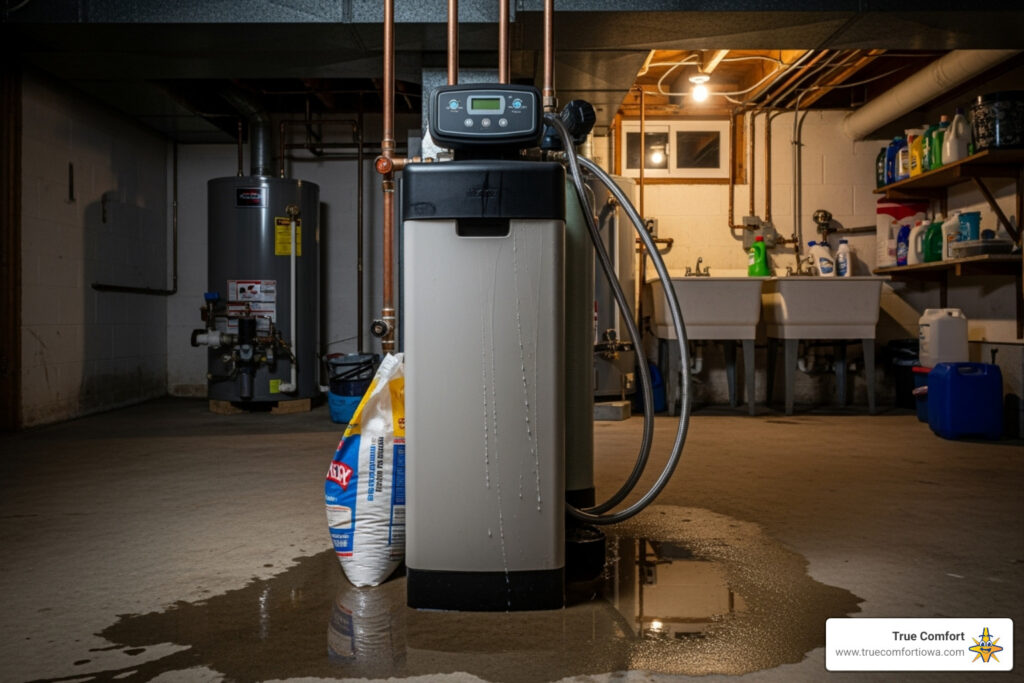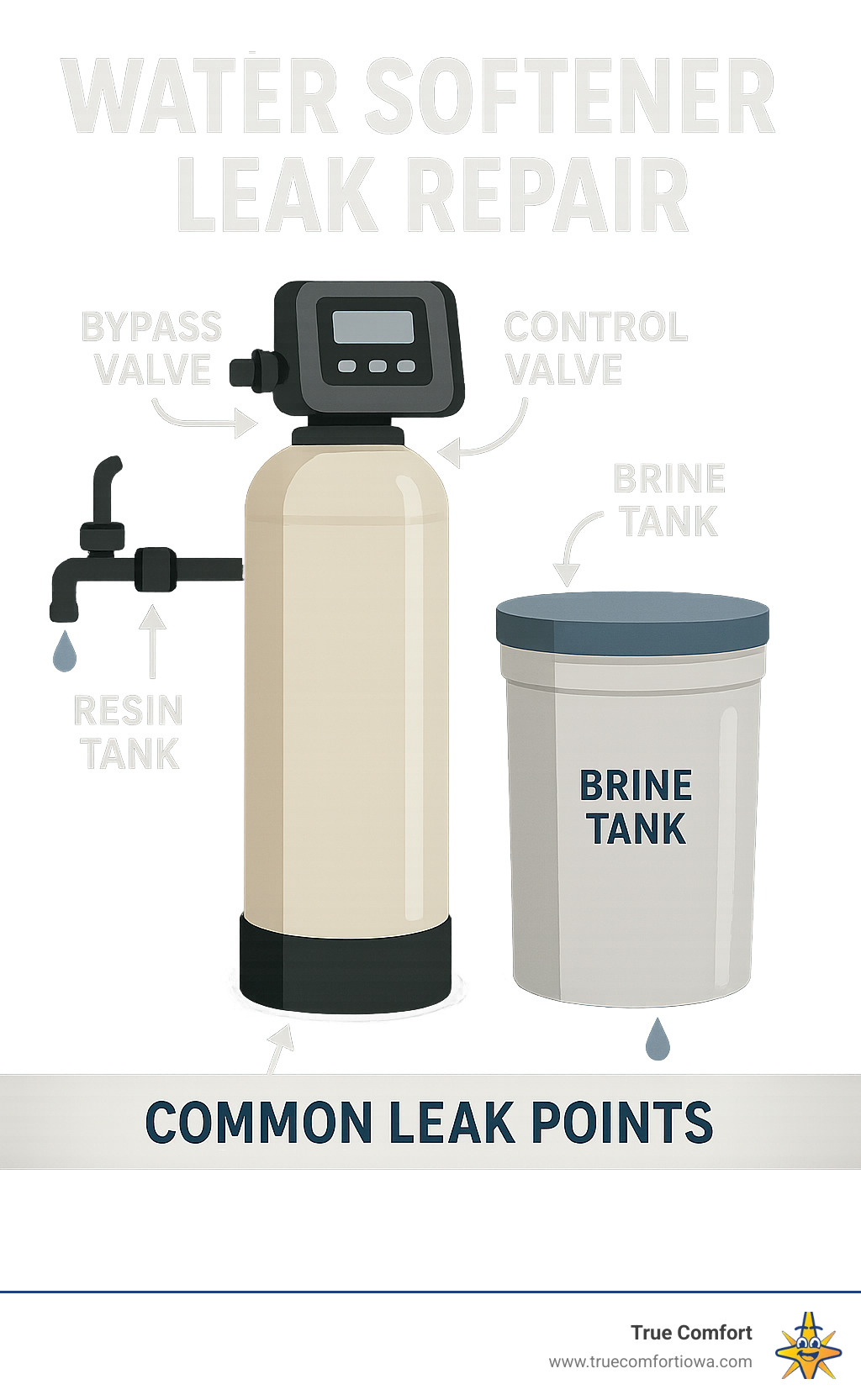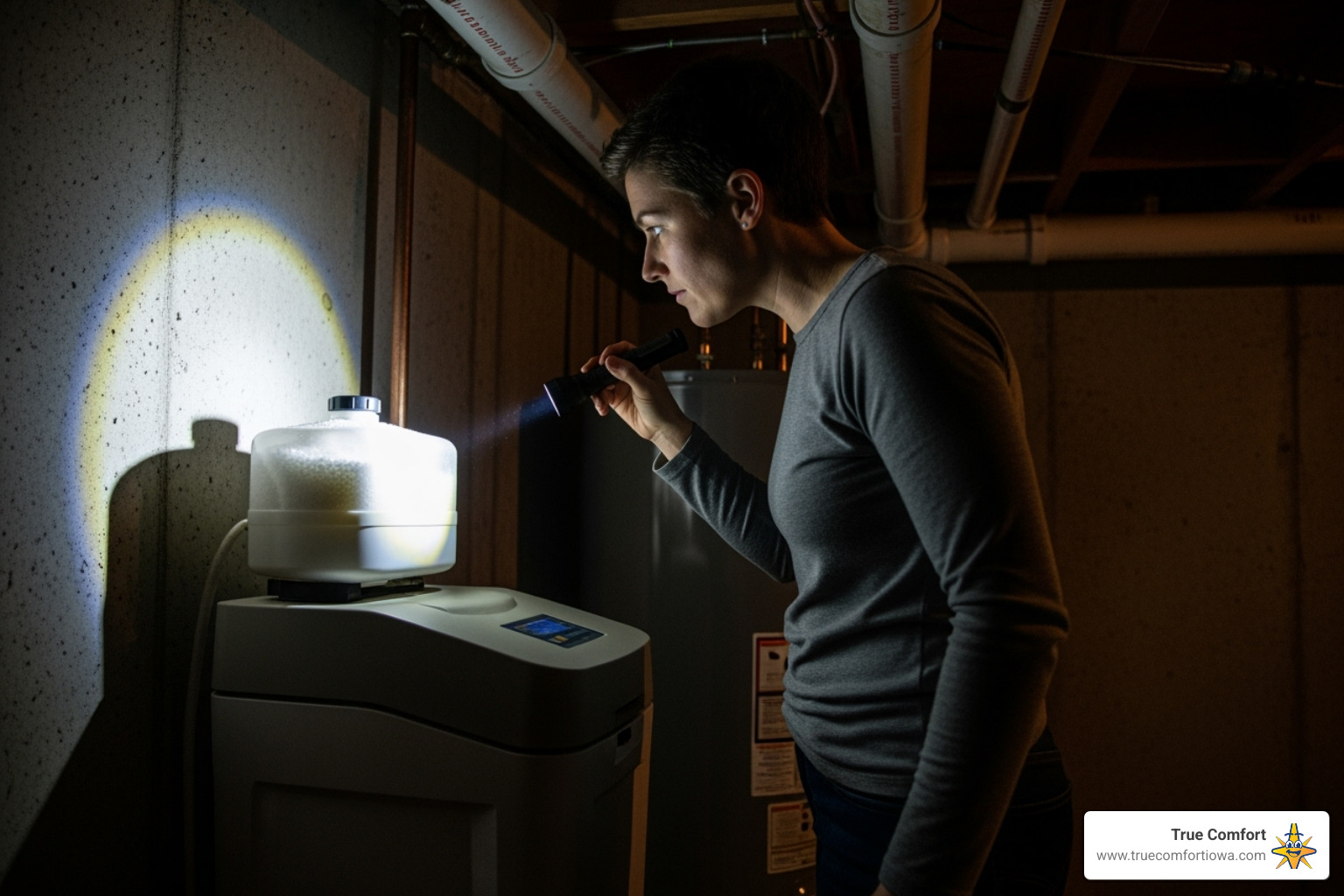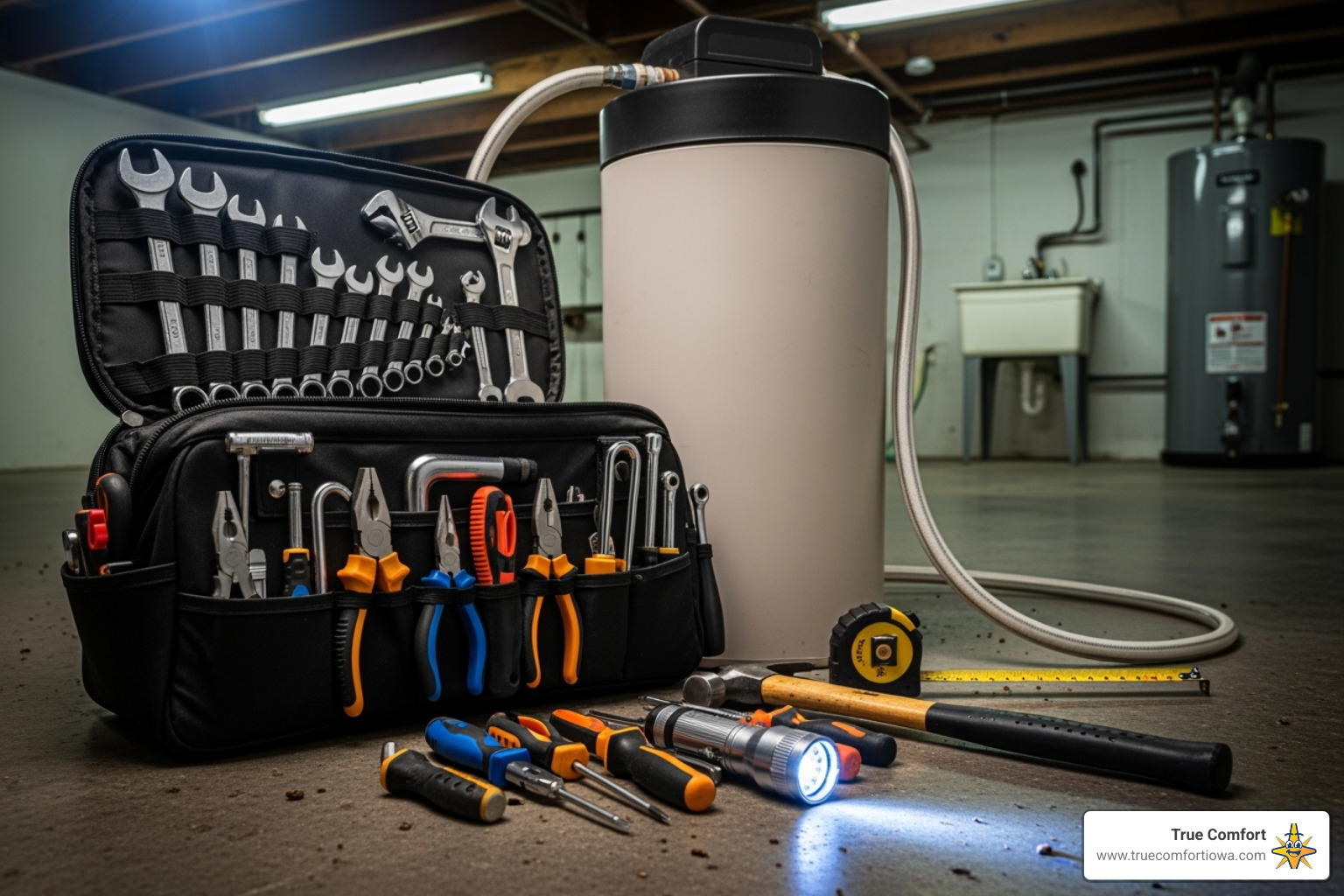Why Water Softener Leak Repair Matters for Your Home
Water softener leak repair is a critical home maintenance task. A leaking water softener can lead to water damage, electrical hazards, and a system that no longer softens your water.
Quick Water Softener Leak Repair Steps:
- Turn off power – Disconnect electricity at the unit or circuit breaker.
- Stop water flow – Use the bypass valve or shut off the main water supply.
- Find the leak source – Check the top (valves), bottom (tanks), and connections.
- Simple fixes – Tighten loose hoses or replace worn O-rings.
- Call professionals – For cracked tanks, valve damage, or electrical issues.
Water softeners last 10-15 years, but leaks can occur at any time. With 85% of American households having hard water, a functioning system is essential. A small drip can quickly escalate, leading to water damage, mold growth, and electrical hazards.
Fortunately, many leaks have simple solutions. Loose hose connections, worn O-rings, and minor valve issues are often DIY fixes. This guide will help you identify leak sources, understand their causes, and determine when to handle repairs yourself versus when to call True Comfort’s experienced technicians.
First Steps: Identifying the Source of the Leak
Finding water near your water softener is alarming, but the key to effective water softener leak repair is to first identify the source. Before grabbing tools, observe what’s happening.
Observe the timing of the leak. Is it a steady drip or intermittent? Occasional leaks often occur during the regeneration cycle, when the softener cleans itself. To confirm, manually start a regeneration cycle and watch for escaping water. This video explains how a water softener works if you’re unfamiliar with the process.
Is It a Leak or Just Condensation?
What appears to be a leak might just be condensation, or “sweating.” This occurs when cold water flows through the tank in a humid environment, like a basement, causing moisture from the air to form droplets on the tank’s exterior. These droplets can run down and create puddles.
To check, wipe the tank dry. If droplets slowly reappear on the surface, it’s condensation. If water actively drips from fittings, hoses, or cracks, it’s a real leak.
Condensation can be fixed by installing an insulating jacket. This video shows you how to install water softener sweat jackets to solve the problem.
Pinpointing the Leak Location
After ruling out condensation, find the exact source of the water. The location indicates the type of water softener leak repair needed.
Leaks from the top often indicate problems with the control valve. A cracked rotor valve or worn seals inside can cause water to escape. Worn O-rings in the bypass valve are another common cause.
Leaks from the bottom usually point to the brine tank (the shorter tank). An aggressive attempt to break up a salt bridge can puncture the tank. A cracked brine tank typically requires replacement.
Hose leaks can be a simple loose connection that needs tightening. The hose itself can also become brittle and crack over time, requiring replacement.
Drain line problems often stem from installation issues rather than wear and tear and may require professional repair.
Water pooling directly under the main resin tank (the taller one) suggests a crack in the tank itself. This is a serious issue that usually means the tank needs to be replaced.
The leak’s location helps determine if it’s a DIY fix or a job for True Comfort professionals. Identifying the source is the first step to a solution.
Common Causes of Water Softener Leaks
Understanding the cause of a leak is as important as finding its source. Most systems last 10-15 years, but with age, plastic parts can become brittle and seals can dry out, leading to leaks.
Other causes include improper installation, which can lead to misaligned parts and loose fittings, or physical damage from bumps or aggressive maintenance.
Issues with the Tanks (Resin & Brine)
When either the resin or brine tank has problems, water softener leak repair is necessary.
The resin tank, where softening occurs, can develop cracks over time, causing water to seep out. The brine tank, which holds the salt, is also vulnerable to damage, often during maintenance.
Salt bridges, a hard crust of salt, are a common issue. Trying to break them with force can puncture the bottom of the brine tank, requiring a replacement.
Overflowing brine tanks are often caused by a malfunctioning float valve. If the float gets stuck or clogged, too much water enters the tank during regeneration. Power failures during regeneration can also cause overflows. A faulty brine valve or damaged rotor valve can also lead to overflows. For more on these issues, see What Causes Water Softener Leaks? How to Fix it?.
Valve and Seal Failures
Valves and seals direct water flow and prevent leaks. When they fail, problems arise.
The rotor valve in the control head directs water flow. When it cracks or its seals wear out, it’s a common source of leaks from the top of the unit.
Bypass valve leaks are often due to worn O-rings, causing small leaks at the valve connections.
O-rings and seals create watertight connections but can dry out, crack, and wear down with age, causing slow, persistent leaks. If you’re dealing with broader plumbing issues, our plumbing services can help.
Connection and Line Problems
Sometimes the leak is from a connection or line, which is often an easy fix.
Loose hose connections are a common and simple repair. Vibrations can loosen fittings over time, and they often just need to be tightened.
The hoses themselves can wear out, cracking or becoming porous. If the hose material is seeping water, it needs replacement.
Drain line issues, such as clogs or improper installation, can cause pressure buildup and leaks or overflows.
Improper plumbing installation can lead to misaligned pipes, poor seals, and incorrect pressure, causing leaks that may not appear immediately. For more on common leaks, visit Leaking Water Softener? Here’s What You Need to Know and Do.
A Step-by-Step Guide to Water Softener Leak Repair
Once you’ve identified the leak’s source and cause, it’s time for action. Many water softener leak repair jobs are suitable for DIY, but it’s important to know your limits.
Simple issues like loose connections or worn O-rings are often DIY-friendly. However, cracked tanks or complex valve problems require professional help. The key is knowing the difference.
Safety First: Preparing for the Repair
Safety is paramount when working on water softeners, as they involve both water and electricity.
- Turn off the power. Unplug the unit. For severe leaks or water near electrical parts, also turn off the corresponding circuit breaker.
- Stop the water flow. Use the bypass valve to redirect water around the softener while maintaining flow to your house. Consult your manual to identify and operate the valve. If there’s no bypass valve, shut off the main water supply to your home.
- Clear the work area. Mop up any standing water to prevent slips and give yourself room to work.
DIY Water Softener Leak Repair for Common Issues
Many common leaks have simple solutions.
- Tighten loose hose connections. Use an adjustable wrench to gently tighten leaky fittings. Be careful not to overtighten, as this can crack plastic parts or strip threads.
- Address worn O-rings. For leaks at drain or brine fittings, the O-ring may be dried out. This may involve removing the fitting and applying plumber’s clear silicone grease to the O-ring.
- Replace the O-ring if it’s cracked, brittle, or won’t seal after greasing. Ensure you get the correct size from a hardware store.
- Check the float valve for an overflowing brine tank. It can become misaligned or clogged. Gently clean it and ensure it moves freely to resolve the issue.
When to Call a Professional for Water Softener Leak Repair
While DIY repairs are great, some situations require professional expertise to avoid further damage.
- Cracked tanks. Both resin and brine tanks are under pressure and require professional replacement to ensure safety and prevent future failures.
- Rotor valve problems. Leaks from the top of the unit involving the intricate rotor valve or its seals require specialized tools and expertise.
- Persistent leaks. If a leak returns after a DIY fix, it likely indicates a deeper problem that needs a professional diagnosis.
- Major water damage or electrical concerns. Significant flooding or water near electrical components is an emergency that requires immediate professional help.
- Age-related issues. For systems over 10 years old with multiple problems, a professional can advise whether to repair or replace the unit. For other plumbing needs, learn more about Water Heater Leaking in Des Moines, IA.
Preventative Maintenance to Avoid Future Leaks
Regular maintenance can prevent future water softener leak repair headaches and extend the life of your system. Just like a car needs oil changes, your water softener needs regular attention to run smoothly.
- Perform regular inspections. Monthly, check for puddles, feel hoses for cracks, and ensure connections are snug. Catching small drips early prevents major problems.
- Use high-quality salt. Cheaper salt contains impurities that can clog your system and cause salt bridges. Stick with salt specifically designed for water softeners to protect your investment.
- Prevent salt bridges. Keep the salt level below halfway in the brine tank to help it dissolve properly. If a bridge forms, break it up gently with a broom handle to avoid puncturing the tank.
- Clean the brine tank. Every few months, remove sludge and undissolved salt from the bottom to prevent clogs and keep the system running efficiently.
- Check your settings. Periodically adjust regeneration cycles to match changes in water hardness or household usage. This prevents the system from overworking.
Water softeners last 10-15 years, though some can last 20 with proper care. As your system ages, pay closer attention to maintenance, especially on O-rings and seals.
If an older system has frequent leaks, consider whether repair or replacement is more cost-effective. While we can help with water softener leak repair, upgrading to a new, efficient system can be the best long-term solution. For more maintenance tips, see our guide on water heater repair.
Frequently Asked Questions about Water Softener Leaks
Homeowners often have the same questions about water softener leak repair. Here are answers to the most common concerns.
Why is my water softener overflowing?
A faulty brine valve, a stuck float, or a clogged drain line can cause the brine tank to take on too much water during regeneration, leading to an overflow.
An overflowing brine tank is a messy but often fixable problem. The most common cause is a faulty float valve in the brine tank; if it gets stuck or fails, the tank will overfill. Power outages during a regeneration cycle can also confuse the system, causing it to overfill when power is restored. Additionally, drainage issues can cause overflows. A clogged or kinked drain line, or a blocked injector, can prevent water from exiting the tank properly.
How does the age of a water softener contribute to leaks?
Water softeners typically last 10-15 years. As they age, plastic components like tanks and valves can become brittle and crack, while seals and O-rings can dry out and fail, leading to leaks.
Like any appliance, water softeners wear out over time. Constant pressure, temperature changes, and salt water exposure cause wear. Plastic tanks and valves can become brittle and crack, while rubber O-rings and seals dry out and lose flexibility. Moving parts inside the control valve also wear down after years of cycling, reducing the effectiveness of seals. Finally, internal mineral buildup can occur, creating blockages and stressing components, which can cause leaks.
Can a leaking water softener cause major damage?
Yes, even a small, slow leak can lead to significant water damage, mold growth, and structural issues over time. A major leak can cause immediate flooding and create electrical hazards.
Even a small drip can cause extensive damage, affecting flooring, subflooring, and structural elements. The damp conditions can also lead to rapid mold growth, which poses a health risk. The combination of water and electricity creates a serious safety risk, including electrocution and fire hazards, especially if the leak is near outlets or other appliances. Furthermore, a leaking softener isn’t working correctly, meaning you face property damage while still having hard water. Prompt water softener leak repair is essential for protecting your home and safety.
Your Partner for a Leak-Free Home
This guide has covered how to identify and understand water softener leaks. Knowing what to look for makes water softener leak repair less overwhelming.
The key takeaways include the importance of regular maintenance and that many common issues, like loose fittings or worn O-rings, are manageable DIY fixes. However, some problems, such as cracked tanks, complex valve issues, or electrical concerns, require a professional. Sometimes, you just want an expert to handle it.
That’s where True Comfort can help. Our experienced technicians handle all types of water softener repairs, from simple to complex. We provide honest assessments and clear solutions—no surprises, no runaround.
Whether you need help diagnosing a stubborn leak, assessing an old system, or simply want the peace of mind that comes with expert service, our Des Moines area team is ready to restore your system to leak-free operation. We’ve seen it all and are equipped to get the job done right.
Don’t let a leaking water softener damage your home or create safety hazards. Contact us for professional water softener services in Des Moines and let us help you get back to enjoying soft water without the worry.





